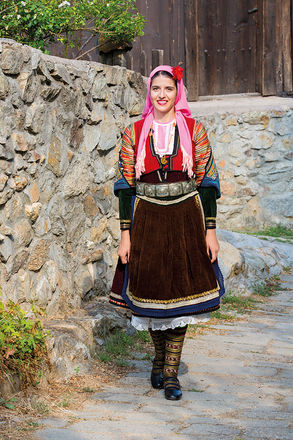Costume calendars 2017
2017 start
"Girl, mari, hubava" 2017
The Bulgarian traditional costume
Clothing occupies an important place in the folkore culture. Undoubtedly, its utilitarian application, but in pre-industrial societies it has another not less important function - ethnic. Through its fabric, color, cut and decoration, the clothing shows the nationality, residence, gender, age, marital status, occupation, social affiliation and religion of the wearer. Different ethnographic groups of the population live in the Bulgarian ethnic territory. Among them there are four main varieties of women's costume: two-apron - typical of the Danube plain; single-apron - found only in some settlements of the Western Rhodopes until the beginning of the XX century; soukman (pinafore) type - covers the central, mostly mountainous and partly flat areas of the country and the type saya, which is distributed south of the type soukman (pinafore) costume. According to the color of the fabrics, men's costumes are divided into two groups: white and black. Their division is not territorial, but temporal. The black costume, the fruit of the commodity production of the abadjii, gradually displaced the earlier white costume from east to west. During the Revival there was a greater variety in clothing. It changes and enriches, depending on changes in taste and material, the emergence of new factory goods and foreign loans. At the same time, there is a transition from the traditional costume to a new type of clothing serving the craft and trade circles. From the beginning of the 20th century, with the disintegration of the traditional way of life, the old costumes of the Bulgarians gradually became obsolete, until finally they were completely forgotten. Today they can be seen "live" only in museums or on the stage of major folk festivals and fairs.
Assoc. Prof. Dr. Angel Yankov, ethnologist

2017 Elhovo
"Elhova Magic" 2017
This project was implemented with the kind assistance of the ETHNOGRAPHIC-ARCHAEOLOGICAL MUSEUM ELHOVO.
The Elhovo cloth costume, impressive with its rich multicolored embroidery, worn by women in the valley downstream of the Tundzha, West Strandzha and Eastern Sakar rivers before the Liberation and in the first few decades after, is one of the most beautiful traditional women's costumes in Bulgaria. . The charm and uniqueness of the costume are determined by the original ornamentation of the main elements of the costume - dress, shirt, apron, belt, outerwear, depending on the season.
There are two main varieties in the real Elhovo costume: ancient Elhovo sukman costume and modern Elhovo sukman costume. In the old Elhovo sukman costume, the sukman has a beautiful and densely embroidered embroidery around the armpit, known as "gazi". Under the dress she puts on a shirt, ornamented with a colorful stripe on the hem. The dress is stocked with a wide belt with diagonally arranged multicolored stripes and an apron, with densely embroidered and rich ornamental decoration in a variety of colors, with geometric or plant motifs - the so-called "thick apron". The beauty of the costume is complemented by various metal and beaded jewelry. The modern Elhovo cloth costume existed from the 1930s to the 1950s. In it the dress has much narrower skirts, the variety of colors and motifs in its decoration is less. The gases of the sukman also have a more uniform embroidery decoration, executed mainly in yellow, most often called "yellow gases". Silk, embroidered sleeves sewn to a cloth vest are worn with the dress. "Dense presses" are replaced by "red", which in the middle and edges are sewn with colorful geometric or floral motifs.
In all its splendor, all varieties of the Elhovo cloth costume can be seen in the exposition and in the fund of the Ethnographic-Archaeological Museum - Elhovo. They are masterpieces of women's embroidery and rich imagination, through which nature and life as a microcosm are transformed into a perfect harmony of colors and colors, causing both national pride and self-confidence in every Bulgarian and admiration and admiration for foreigners.
Hristo Hristov - Director of the Ethnographic and Archaeological Museum - Elhovo



















